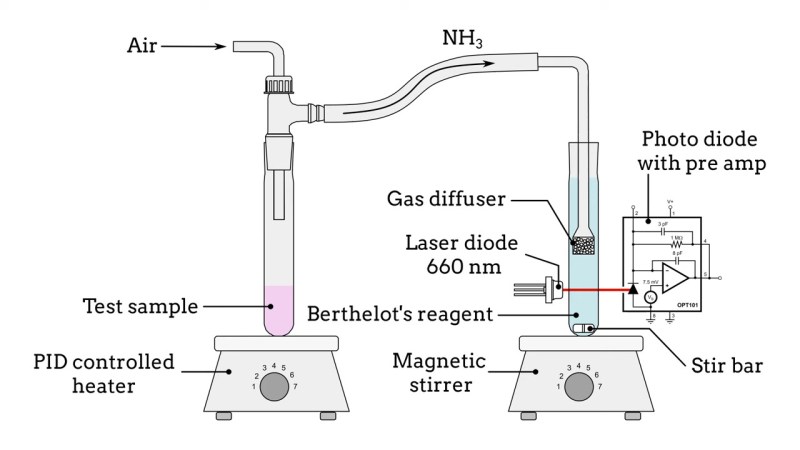We’ve all got our health-related crosses to bear, and even if you’re currently healthy, it’s only a matter of time before entropy catches up to you. For [Markus Bindhammer], it caught up to him in a big way: liver disease, specifically cirrhosis. The disease has a lot of consequences, none of which are pleasant, like abnormally high ammonia concentration in the blood. So naturally, [Markus] built an ammonia analyzer to monitor his blood.
Measuring the amount of ammonia in blood isn’t as straightforward as you think. Yes, there are a few cheap MEMS-based sensors, but they tend to be good only for qualitative measurements, and other solid-state sensors that are more quantitative tend to be pretty expensive since they’re mostly intended for industrial applications. [Marb]’s approach is based on the so-called Berthelot method, which uses a two-part reagent. In the presence of ammonia (or more precisely, ammonium ions), the reagent generates a dark blue-green species that absorbs light strongly at 660 nm. Measuring the absorbance at that wavelength gives an approximation of the ammonia concentration.
[Marb]’s implementation of this process uses a two-stage reactor. The first stage heats and stirs the sample in a glass tube using a simple cartridge heater from a 3D printer head and a stirrer made from a stepper motor with a magnetic arm. Heating the sample volatilizes any ammonia in it, which mixes with room air pumped into the chamber by a small compressor. The ammonia-laden air moves to the second chamber containing the Berthelot reagent, stirred by another stepper-powered stir plate. A glass frit diffuses the gas into the reagent, and a 660-nm laser and photodiode detect any color change. The video below shows the design and construction of the micro lab along with some test runs.
We wish [Markus] well in his journey, of course, especially since he’s been an active part of our community for years. His chemistry-related projects run the gamut from a homebrew gas chromatograph to chemical flip flops, with a lot more to boot.
















And before you accuse Markus of being an alcoholic: cirrhosis can have multiple causes, from hepatitis to NASH (nonalcoholic steatohepatitis).
Elevated ammonia in the blood can also be caused by severe dehydration.
That causes elevated-almost-everything and is easily cured ;-)
Also some drugs (anti-epileptics, anti-cancer) can cause it as well.
Just sad that he sort of had to build it since his insurance only reimburses one test per year. That’s borderline criminal.
Stay healthy Marb, I love your work and look forward to see your posts for many years to come! Your prototypes look great and your unique style is very recognizable.
So he’s going to withdraw a large enough sample of blood from himself on a regular basis to do this? I suppose the vacuum vials must be readily available and other people seem to be able to hit veins on a regular basis. It just never struck me as something anyone would try to do at home.
oh yeah if your willing to cut some corners you can order viable stuff to do this out of china for a paltry amount of money.